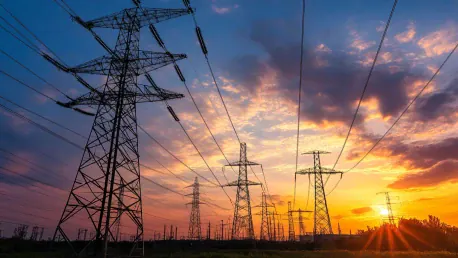The rapid surge in electricity demand within the PJM Interconnection footprint has necessitated an unprecedented collaboration among three major utility companies. For the first time, Dominion Energy Virginia, American Electric Power, and FirstEnergy Corp. are joining forces to address mounting energy challenges, aiming to bolster grid reliability and meet future energy demands head-on.
Regional Collaboration for Enhanced Reliability
Partners in Innovation
Dominion Energy Virginia, American Electric Power, and FirstEnergy Corp. have initiated a partnership aimed at fortifying the energy infrastructure within the PJM Interconnection territory. This unprecedented move marks a pivotal shift toward regional cooperation in the energy sector. By pooling resources and expertise, these utility giants are better equipped to handle escalating energy challenges and ensure a stable power supply.
This collaboration is more than a simple alliance; it signifies an important commitment to address the pressing needs of a rapidly evolving energy landscape. The move exemplifies a strategic approach to shared challenges, turning competitors into partners for the greater good of energy reliability and customer service. As these companies collaborate, they can efficiently allocate their unique strengths and insights, thereby offering innovative solutions to broader, regional issues that no single entity could tackle alone.
The Scope and Significance of PJM Interconnection
PJM Interconnection supervises the wholesale electricity dissemination across 13 states, encompassing regions from the Mid-Atlantic to the Midwest and the South. With its vast geographical spread and significant population density, maintaining grid reliability in the PJM region is crucial. The collaboration among the utility companies includes several regional electric transmission projects designed to enhance grid robustness and adaptability.
PJM’s oversight covers a considerable segment of the U.S. population, making its role vital in ensuring that electrical services remain uninterrupted and efficient. This expansive area not only faces increasing electricity demands due to growing populations but also requires robust infrastructure to withstand environmental and technological changes. By collaborating on several pivotal projects, the utilities aim to create a more resilient grid capable of supporting both existing and future needs, safeguarding against outages and inefficiencies.
Drivers of Increasing Energy Demand
Electrification and Data Centers
A significant driver behind the rising electricity demand is the swift pace of electrification, coupled with the exponential growth of data centers. These centers primarily support the burgeoning field of artificial intelligence, necessitating a substantial and reliable energy supply. The drive toward increased digitalization is putting unprecedented pressure on the existing grid infrastructure, making collaborative efforts all the more essential.
The proliferation of data centers is not merely a trend but a critical shift in how we store, process, and utilize information. As companies and governments increasingly rely on AI and machine learning, the power needs of data centers grow exponentially. These centers house thousands of servers, all of which require constant power to operate efficiently, which, in turn, demands robust, reliable electricity sources. Utilities must rapidly adapt to this new landscape by upgrading infrastructure to handle higher loads and prevent potential bottlenecks.
Demographic Pressures
The PJM Interconnection footprint includes some of the most densely populated areas in the United States. Forecasts indicate that power demand in these regions will continue to climb steadily over the next decade. The need to accommodate this growth without compromising reliability is a driving force behind the proposed regional projects.
In densely populated regions, the demand for electricity rises not only from residential use but also from commercial and industrial activities. As urban centers expand, so too does their energy requirement, mandating utilities to enhance their infrastructure continually. This upward trajectory amplifies the urgency of implementing robust systems capable of meeting future demands. By focusing on regional cooperation, the involved utilities aim to preemptively address potential issues before they arise, ensuring uninterrupted power for millions.
Transition to Clean Energy
Ambitious Renewable Goals
States within the PJM region are actively pursuing ambitious renewable energy targets, prompting utility companies to adjust their energy portfolios. This transition from traditional fossil fuels to renewable energy sources is essential for achieving long-term sustainability goals but also introduces new challenges in terms of grid management and stability.
Such ambitious renewable energy goals reflect a broader shift within the industry towards sustainability, yet this shift isn’t without its complications. Integrating renewable energy sources like wind and solar into the existing grids necessitates substantial infrastructural changes. While these sources are cleaner, they are also intermittent, meaning their energy production isn’t constant. Efforts are required to balance intermittent supplies with consistent demand, ensuring the grid remains stable and reliable.
Grid Strain from Renewable Integration
The shift towards cleaner, renewable energy sources adds a layer of complexity to grid management. The integration of solar, wind, and other renewables requires modernizing existing infrastructure to handle intermittent power supplies effectively. The utilities’ proactive planning aims to mitigate the strain on the grid and ensure a seamless transition to renewable energy.
Modernizing infrastructure involves implementing advanced technologies, such as smart grids and enhanced storage solutions, to manage fluctuating supplies effectively. By doing so, utilities can store excess energy during peak production times and distribute it when production dips, maintaining a consistent supply. These upgrades ensure that the power remains reliable, irrespective of the variable output from renewable sources. Moreover, through collaborative planning, utilities can share insights and strategies, reducing the overall strain and making the grid more flexible and adaptive.
Virginia: The Epicenter of Energy Demand Growth
Surge in Data Center Development
Virginia, heralded as the “data center capital of the world,” epitomizes the rapid growth in power demand. Fueled by the expansion of these energy-intensive facilities, Virginia’s annual electricity demand is growing at a rate of over 5%, poised to double within the next 15 years. This growth outpaces historical rates and underscores the need for robust energy planning.
The concentration of data centers in Virginia stands as a testament to the state’s pivotal role in the digital economy. These facilities, essential for supporting various technological advancements, require vast amounts of energy to maintain their operations. As more organizations worldwide demand high-performance computing capabilities, Virginia’s power grid faces unprecedented pressure. This scenario highlights the urgent necessity for comprehensive planning and timely infrastructure developments to keep pace with this remarkable growth.
Historical Context and Future Projections
The current growth rate in Virginia’s power demand is nearly five times higher than in the past 15 years, reflecting a dramatic surge not seen since the post-WWII era. This exponential increase necessitates comprehensive infrastructure enhancements to prevent potential energy shortages and maintain grid stability.
This rapid escalation in demand presents both a challenge and an opportunity. Addressing these needs proactively allows for the creation of a more robust and future-proof grid. Historical data reveals that previous growth cycles required significant infrastructural adaptation to meet increasing energy needs. Today’s context, however, demands even more innovative solutions to ensure sustainability, reliability, and efficiency due to the pace of technological advancement and electrification.
Infrastructure Projects to Meet Demand
High-Voltage Transmission Lines
The utilities’ collaborative proposal includes the construction of new high-voltage transmission lines across key regions such as Virginia, Ohio, and West Virginia. These lines, ranging from 765-kV to 345-kV, are pivotal in enhancing the transmission capacity and reliability of the grid.
High-voltage transmission lines are essential components of an efficient and reliable power network, capable of transferring large amounts of electricity over long distances with minimal loss. By implementing these new lines, the utility companies aim to significantly boost the grid’s efficiency, ensuring that power generated in one region can be effectively distributed to where it is most needed. This interconnected approach helps prevent localized outages and ensures that growing areas receive adequate power supplies.
Submission to RTEP
The proposed projects have been formally submitted to PJM’s Regional Transmission Expansion Plan (RTEP), which is vital for maintaining grid reliability. The approval and implementation process is extensive, requiring route selection, environmental studies, and permitting—steps that ensure the projects’ feasibility and efficiency.
Submitting these projects to PJM’s RTEP is a critical step in securing the necessary approvals and funding for these expansive infrastructure initiatives. The rigorous evaluation process ensures that all aspects of the projects—environmental, logistical, and technical—are thoroughly vetted. This comprehensive assessment guarantees that the projects not only meet current needs but are also designed to adapt to future requirements, thereby safeguarding long-term grid stability and sustainability.
Financial Implications and Consumer Impact
Preliminary Financial Uncertainty
While the urgency of the proposed projects is clear, it remains too early to predict the financial impact on consumers. PJM’s selection timeline extends into early 2025, during which the detailed financial implications will become clearer. The multi-year process will consider various factors to ensure cost-effectiveness and consumer welfare.
The complexity of these large-scale projects means that a myriad of elements will influence the final cost to consumers. These include construction costs, environmental mitigation expenses, and potential economic benefits such as improved grid reliability and reduced outage durations. As utilities navigate this intricate landscape, their focus remains on balancing project costs with the imperative to provide reliable, affordable energy to all consumers, ensuring any financial impact is justified by the benefits delivered.
Comprehensive Assessment Process
Selected projects will undergo rigorous evaluation involving environmental studies, route optimization, and public consultations. This detailed assessment process aims to minimize any adverse impacts while maximizing operational efficiency and grid reliability.
An exhaustive assessment process is essential to address any concerns and mitigate potential disruptions. Environmental studies ensure that new infrastructure projects comply with regulations and do not harm local ecosystems. Route optimization seeks the most efficient paths for new lines to minimize land use conflicts and maximize efficiency. Public consultations provide a platform for community input, ensuring local voices are heard and considered in the planning process. Collectively, these steps ensure that the projects are viable, sustainable, and beneficial for all stakeholders.
Continued Infrastructure Development
Additional Transmission Initiatives
In addition to their collaborative efforts, Dominion Energy, American Electric Power, and FirstEnergy Corp. have individually proposed other transmission initiatives. These additional projects underscore a sustained emphasis on improving the region’s energy infrastructure to meet emerging demands and support renewable energy integration.
The ongoing efforts highlight a broader commitment within the energy sector to continual improvement and innovation. By proposing independent initiatives alongside collaborative projects, the utilities demonstrate their dedication to not only maintaining but also enhancing grid reliability and capacity. These efforts are critical as the industry adapts to evolving energy landscapes characterized by increasing demand, renewable energy integration, and technological advancements.
Commitment to Long-term Planning
The commitment to extensive planning and infrastructure development reflects a balanced approach to addressing current challenges and future energy uncertainties. By focusing on long-term strategies, the utilities are preparing to meet growing energy needs while ensuring sustainability and reliability.
Long-term planning is crucial for anticipating and addressing future energy requirements. As the industry shifts towards cleaner energy sources and faces unpredictable demand surges, having a robust, adaptive infrastructure in place is essential. The collaborative and individual initiatives by these utility giants embody a proactive approach to energy management, aiming to create a resilient grid capable of withstanding both immediate and long-term challenges. This multi-faceted strategy ensures that the region’s energy needs are met efficiently and sustainably.
Conclusion and Main Findings
The PJM Interconnection region is experiencing a significant jump in electricity demand, prompting a historic alliance among three major utility companies. In an unprecedented move, Dominion Energy Virginia, American Electric Power, and FirstEnergy Corp. are coming together to tackle the escalating energy challenges. This collaboration is viewed as a critical step to enhance grid reliability and ensure that future energy needs are adequately met.
Given the rapid growth in demand, this joint effort is essential for maintaining a stable and resilient power grid. Each company brings unique strengths and resources to the table, allowing for a comprehensive approach to addressing the complexities of modern energy requirements. This partnership will not only help manage the current surge in demand but also lay the groundwork for future energy innovations and improvements.
By pooling their expertise, Dominion Energy Virginia, American Electric Power, and FirstEnergy Corp. aim to create a more dependable and robust energy system. This collaboration represents a forward-thinking strategy to meet both current and future energy demands efficiently, ensuring that consumers continue to receive reliable power.









